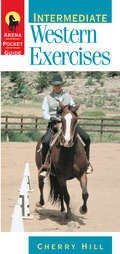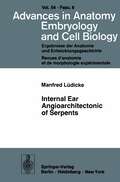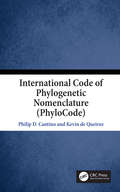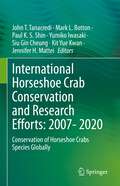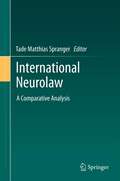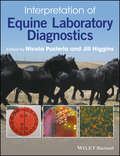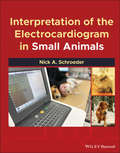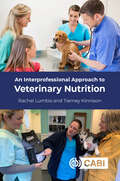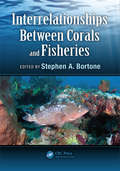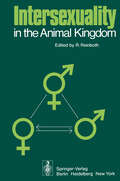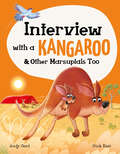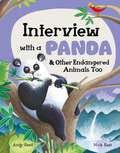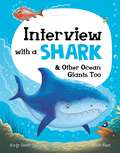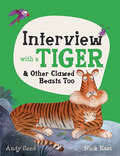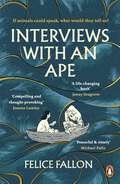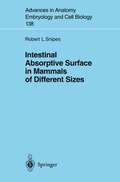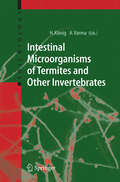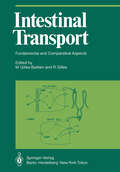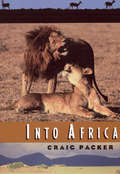- Table View
- List View
Intermediate Western Exercises
by Cherry HillTake your riding to the next level! Hone balance, tighten transitions, and begin collection as you develop your Western riding skills. In this equestrian workbook, veteran trainer Cherry Hill presents a series of focused exercises that include clearly stated goals, illustrated directions, arena maps, and appropriate safety concerns. With a pocket-sized trim perfect for easy reference in the saddle, this book is designed to help you improve your riding form and maximize the benefits of your training sessions.
Internal Ear Angioarchitectonic of Serpents (Advances in Anatomy, Embryology and Cell Biology #54/6)
by M. LüdickeInternational Code of Phylogenetic Nomenclature (PhyloCode): A Phylogenetic Code of Biological Nomenclature
by Kevin de Queiroz Philip D. CantinoThe PhyloCode is a set of principles, rules, and recommendations governing phylogenetic nomenclature, a system for naming taxa by explicit reference to phylogeny. In contrast, the current botanical, zoological, and bacteriological codes define taxa by reference to taxonomic ranks (e.g., family, genus) and types. This code will govern the names of clades; species names will still be governed by traditional codes. The PhyloCode is designed so that it can be used concurrently with the rank-based codes. It is not meant to replace existing names but to provide an alternative system for governing the application of both existing and newly proposed names. Key Features Provides clear regulations for naming clades Based on expressly phylogenetic principles Complements existing codes of nomenclature Eliminates the reliance on taxonomic ranks in favor of phylogenetic relationships Related Titles: Rieppel, O. Phylogenetic Systematics: Haeckel to Hennig (ISBN 978-1-4987-5488-0) de Queiroz, K., Cantino, P. D. and Gauthier, J. A. Phylonyms: A Companion to the PhyloCode (ISBN 978-1-138-33293-5).
International Code of Phylogenetic Nomenclature (PhyloCode): A Phylogenetic Code of Biological Nomenclature
by Kevin de Queiroz Philip D. CantinoThe PhyloCode is a set of principles, rules, and recommendations governing phylogenetic nomenclature, a system for naming taxa by explicit reference to phylogeny. In contrast, the current botanical, zoological, and bacteriological codes define taxa by reference to taxonomic ranks (e.g., family, genus) and types. This code will govern the names of clades; species names will still be governed by traditional codes. The PhyloCode is designed so that it can be used concurrently with the rank-based codes. It is not meant to replace existing names but to provide an alternative system for governing the application of both existing and newly proposed names. Key Features Provides clear regulations for naming clades Based on expressly phylogenetic principles Complements existing codes of nomenclature Eliminates the reliance on taxonomic ranks in favor of phylogenetic relationships Related Titles: Rieppel, O. Phylogenetic Systematics: Haeckel to Hennig (ISBN 978-1-4987-5488-0) de Queiroz, K., Cantino, P. D. and Gauthier, J. A. Phylonyms: A Companion to the PhyloCode (ISBN 978-1-138-33293-5).
International Horseshoe Crab Conservation and Research Efforts: Conservation of Horseshoe Crabs Species Globally
by John T. Tanacredi Mark L. Botton Paul K. S. Shin Yumiko Iwasaki Siu Gin Cheung Kit Yue Kwan Jennifer H. MatteiThe first International Conference on Horseshoe Crab’s Conservation conducted at Dowling College, USA, (2007) and it’s proceedings published by Springer in 2009, prompted the continued research and conservation efforts presented at subsequent conferences and colloquium in Hong Kong, Taiwan, (2011); San Diego, CA, (2014), (CERF); Japan, Sasebo (2015) and an accepted inclusion for a special session on Horseshoe Crabs at the 2017 CERF Conference held in Providence, RI, USA. All these aforementioned conferences contributed manuscripts, posters, workshop “position papers”, and oral presentations the majority of which have not been published in total. In 2015, Carmichael et al. had published by Springer the majority of manuscripts from the 2011 Hong Kong / Taiwan conference. However, workshop results and all subsequent presentations and workshops were not. The Japan conference presented over 40 papers alone. A collection of all workshop summaries, poster presentations and new manuscript submittals (San Diego, CA; Sasebo, Japan; and Providence, RI) as well as products prepared for the IUCN World Congress in Hawaii, (2016), are included potential contributions for review in this compilation now available for global distribution in this Springer Nature publication.The “Proceedings of International Conferences on the Biology and Conservation of Horseshoe Crabs”, thus contains over 50 manuscripts and a diversified collection of documents, photos and memorabilia covering all four of the horseshoe crab species globally: their biology, ecology evolution, educational, and societal importance. This book exposes the impacts that humans have imposed on all four of these species, revealing through the coordinated effort of horseshoe crab scientists with the IUCN, of the worldwide need for a clear conservative effort to protect these paleo- survival organisms from a looming extinction event. Biologists, conservationists, educators, and health professionals will all welcome this book not only for exploration of its pharmacological interest, but also for the mystery of their longevity. This book also clarifies the future research needs and the conservation agenda for the species worldwide. Anyone working or studying estuaries on a global scale, will need to obtain this seminal work on horseshoe crabs.
International Neurolaw: A Comparative Analysis
by Tade Matthias Matthias SprangerWhereas the past few years have repeatedly been referred to as the “era of biotechnology”, most recently the impression has emerged that at least the same degree of attention is being paid to the latest developments in the field of neurosciences. It has now become nearly impossible to maintain an overview of the number of research projects dealing with the functionality of the brain – for example concerning its organizational structure – or projects dealing with the topics of legal responsibility, brain-computer interface applications, neuromarketing, lie detection or mind reading. These procedures are connected to a number of legal questions concerning the framework conditions of research projects as well as the right approach to the findings generated. Given the primary importance of the topic for the latest developments, it is essential to compare the different legal systems and strategies that they offer for dealing with these legal implications. Therefore, the book International Neurolaw – A Comparative Analysis contains several country reports from around the world, as well as those of international organizations such as UNESCO, in order to show the different legal approaches to the topic and possible interactions.
The Interpretation of Cats: And Their Owners
by Claude Béata‘A guide to being the best humans we can be for our cats’ Focus'Fascinating. A must for every cat owner' Philippa Perry A trail-blazing guide to feline mental health from a leading veterinary psychiatristIs your cat happy? What can you do to help? And what can cats teach us? The relationship between humans and cats has never been simple. Cats are mysterious and contradictory, independent and affectionate, predator and prey. Their true nature continues to elude us, and their subtle and complex behavioural problems can often seem unsolvable or incomprehensible.In this ground-breaking book – a huge bestseller in its native France – veterinary doctor and psychiatrist Claude Béata draws on cutting-edge research and decades of experience with cats, to revolutionize our understanding of pets and transform our appreciation of feline mental wellbeing. Here, we meet Nougatine, a Siamese suffering from bipolar dysthymic disorder, Tabatha, an anxious Ragdoll with attachment issues, and Melly, an Abyssinian struggling with a feline form of schizophrenia – as well as their owners who seek advice and support.Charming, surprising, and offering illuminating insight into a range of disorders, Béata’s book calls for greater compassion and provides a new way of understanding cat psychiatry so we can care for the mental, and physical wellness of our beloved pets.
Interpretation of Equine Laboratory Diagnostics
by Nicola Pusterla Jill HigginsInterpretation of Equine Laboratory Diagnostics offers a comprehensive approach to equine laboratory diagnostics, including hematology, clinical chemistry, serology, body fluid analysis, microbiology, clinical parasitology, endocrinology, immunology, and molecular diagnostics. Offers a practical resource for the accurate interpretation of laboratory results, with examples showing real-world applications Covers hematology, clinical chemistry, serology, body fluid analysis, microbiology, clinical parasitology, endocrinology, immunology, and molecular diagnostics Introduces the underlying principles of laboratory diagnostics Provides clinically oriented guidance on performing and interpreting laboratory tests Presents a complete reference to establish and new diagnostic procedures Offers a practical resource for the accurate interpretation of laboratory results, with examples showing real-world applications Covers hematology, clinical chemistry, serology, body fluid analysis, microbiology, clinical parasitology, endocrinology, immunology, and molecular diagnostics Introduces the underlying principles of laboratory diagnostics Provides clinically oriented guidance on performing and interpreting laboratory tests Presents a complete reference to established and new diagnostic procedures
Interpretation of Equine Laboratory Diagnostics
by Nicola Pusterla Jill HigginsInterpretation of Equine Laboratory Diagnostics offers a comprehensive approach to equine laboratory diagnostics, including hematology, clinical chemistry, serology, body fluid analysis, microbiology, clinical parasitology, endocrinology, immunology, and molecular diagnostics. Offers a practical resource for the accurate interpretation of laboratory results, with examples showing real-world applications Covers hematology, clinical chemistry, serology, body fluid analysis, microbiology, clinical parasitology, endocrinology, immunology, and molecular diagnostics Introduces the underlying principles of laboratory diagnostics Provides clinically oriented guidance on performing and interpreting laboratory tests Presents a complete reference to establish and new diagnostic procedures Offers a practical resource for the accurate interpretation of laboratory results, with examples showing real-world applications Covers hematology, clinical chemistry, serology, body fluid analysis, microbiology, clinical parasitology, endocrinology, immunology, and molecular diagnostics Introduces the underlying principles of laboratory diagnostics Provides clinically oriented guidance on performing and interpreting laboratory tests Presents a complete reference to established and new diagnostic procedures
Interpretation of the Electrocardiogram in Small Animals
by Nick A. SchroederInterpretation of the Electrocardiogram in Small Animals Explore this easy-to-follow clinical manual on how to interpret electrocardiograms in canine and feline patientsInterpretation of the Electrocardiogram in Small Animals delivers a simplified and accessible approach to electrocardiography interpretation for veterinarians treating dogs and cats. This practical manual covers a comprehensive list of arrhythmias and associated phenomena using an easy-to-follow format, with hundreds of electrocardiograms and ladder diagrams supporting the text.The book focuses on the clinical applications of electrocardiographic interpretation, with less emphasis on physics and subcellular mechanisms, making the book a useful patient-side resource. Interpretation of the Electrocardiogram in Small Animals offers readers an up-to-date understanding and knowledge of common and rare phenomena alike.Beginning with a description of the single cardiac cycle as illustrated by surface EKG, the book moves on to describe variations on the P-QRS-T complex that occur in response to chamber enlargement and hypertrophy. Readers will also benefit from the inclusion of:A detailed discussion of aberrancy and its differentiation from ventricular ectopyA thorough exploration of arrhythmias and conduction disorders including escape mechanisms, atrioventricular block, extrasystoles, accelerated rhythms, tachycardias, flutter and fibrillationAn examination of pacemaker basics, as well as a few common abnormalities and pacemaker problems, including undersensing, oversensing, and failure to captureInterpretation of the Electrocardiogram in Small Animals is a convenient, one-stop reference for the interpretation of electrocardiography in small animals for veterinary students, residents, and specialists as well as for small animal general practitioners.
Interpretation of the Electrocardiogram in Small Animals
by Nick A. SchroederInterpretation of the Electrocardiogram in Small Animals Explore this easy-to-follow clinical manual on how to interpret electrocardiograms in canine and feline patientsInterpretation of the Electrocardiogram in Small Animals delivers a simplified and accessible approach to electrocardiography interpretation for veterinarians treating dogs and cats. This practical manual covers a comprehensive list of arrhythmias and associated phenomena using an easy-to-follow format, with hundreds of electrocardiograms and ladder diagrams supporting the text.The book focuses on the clinical applications of electrocardiographic interpretation, with less emphasis on physics and subcellular mechanisms, making the book a useful patient-side resource. Interpretation of the Electrocardiogram in Small Animals offers readers an up-to-date understanding and knowledge of common and rare phenomena alike.Beginning with a description of the single cardiac cycle as illustrated by surface EKG, the book moves on to describe variations on the P-QRS-T complex that occur in response to chamber enlargement and hypertrophy. Readers will also benefit from the inclusion of:A detailed discussion of aberrancy and its differentiation from ventricular ectopyA thorough exploration of arrhythmias and conduction disorders including escape mechanisms, atrioventricular block, extrasystoles, accelerated rhythms, tachycardias, flutter and fibrillationAn examination of pacemaker basics, as well as a few common abnormalities and pacemaker problems, including undersensing, oversensing, and failure to captureInterpretation of the Electrocardiogram in Small Animals is a convenient, one-stop reference for the interpretation of electrocardiography in small animals for veterinary students, residents, and specialists as well as for small animal general practitioners.
An Interprofessional Approach to Veterinary Nutrition
by Rachel Lumbis Tierney KinnisonIn veterinary practice, the interface between veterinarians, veterinary nurses or technicians, and paraprofessional team members is crucial. It influences patient care, incidence of medical errors, client satisfaction, success of the veterinary practice and revenue generation. Ensuring a coherent approach to the maintenance of animal health and wellbeing is of paramount importance, yet challenges such as interprofessional prejudice, misunderstanding of motivations, and a lack of recognition, respect, empowerment or trust, can prevent best practice. Nutrition is one of the most important considerations in the maintenance of health, and plays a critical role in disease management, patient recovery and hospital outcome; a reflection of its recognition as the fifth vital assessment. Owners are increasingly aware of the role of nutrition in optimising pet health, yet considerable misinformation can make this one of the most difficult aspects of pet ownership. Playing a central role as a source of expert information, veterinary healthcare teams must rise to the challenge of optimising pet nutrition. Effective interprofessional communication and collaboration is considered a key factor in the successful implementation of nutritional assessment, and a positive team environment founded on respect, trust and mutual support helps overcome challenges and provide the best outcome for both pets and their owners. This book provides evidence-based theory in an accessible and practical way to help veterinary healthcare teams implement interprofessional approaches to nutritional care and support.
Interrelationships Between Corals and Fisheries
by Ph.D., Stephen BortoneInterrelationships Between Corals and Fisheries is derived from a workshop held by the Gulf of Mexico Fishery Management Council in Tampa, Florida in May 2013, where world authorities came together to discuss the current problems in managing tropical fisheries and offered suggestions for future directions for both researchers and environmental reso
Intersexuality in the Animal Kingdom
by R. ReinbothWhen Richard Goldschmidt' coined the term "intersexuality" in 1915, he intended it to apply to normally dioecious species which exhibit some kind of mixture between male and female characters. However, as knowledge of the bewildering variability present in the sexual orga nization of members of the animal kingdom has increased, the original meaning of the word has changed. Today many authors define inter sexuality as "the presence of both male and female characteristics, or of intermediate sexual characteristics, in a single individual".2 This more extensive and widely accepted concept justifies the title of our book •. Among all the anatomical and physiological features of living organisms the reproductive system has a unique importance for the perpetuation of the species. Conversely, reproductive processes are of little or no account for the viability of the individual. Therefore, within the framework of general biology reproduction has all too often been looked at solely from the point of view of genetics. Lively discussions about genotypic versus phenotypic sex determination long dominated the sci entific literature on sexuality in animals; this one-sided emphasis has tended to obscure many important facets of an organism's ability to reproduce. Recent developments in current biological research have brought the classic problem of sex differentiation into focus again, and the rapid progress being made in comparative endocrinology has added a new di mension to the study of reproductive biology.
Interview with a Kangaroo: And Other Marsupials Too (Interview with a… #3)
by Andy SeedIf you could talk to animals, what would you ask? Get familiar with 10 extraordinary marsupials as they step up to the mic and share their habits, behaviour, likes and dislikes, favourite foods, and more. Each animal has its own story to tell… and its own attitude!In this fun and fact-filled book, bite-sized text in a question-and-answer format is paired with colourful and engaging illustrations throughout, perfect for emerging or reluctant readers, or any young animal enthusiast who enjoys a bit of humour!Features 'interviews' with a kangaroo, koala, Virginia opossum, Tasmanian Devil, numbat, bandicoot, sugar glider, quokka and spotted cuscus. Plus, ideas for how to do your bit to help endangered species.Look out for other titles in the series: Interview with a Tiger and Interview with a Shark!
Interview with a Panda: And Other Endangered Animals Too (Interview with a… #4)
by Andy SeedIf you could talk to animals, what would you ask?Get familiar with 10 endangered animals as they step up to the mic and share their habits, behaviour, likes and dislikes, favourite foods, and more. Each animal has its own story to tell... and its own attitude!In this fun and fact-filled book, bite-sized text in a question-and-answer format is paired with colourful and engaging illustrations throughout, perfect for emerging or reluctant readers, or any young animal enthusiast who enjoys a bit of humour!Features 'interviews' with a giant panda, green turtle, black rhino, flying fox, Sumatran elephant, Cuban crocodile, tiger chameleon, kakapo and Western Nimba toad. Plus, ideas for how to do your bit to help endangered species.Look out for other titles in the series: Interview with a Tiger, Interview with a Shark, Interview with a Kangaroo!
Interview with a Shark: And Other Ocean Giants Too (Interview with a… #2)
by Andy SeedIf you could talk to animals, what would you ask?Get familiar with 10 extraordinary ocean giants as they step up to the mic and share their habits, behaviour, likes and dislikes, favourite foods, and more. Each animal has its own story to tell... and its own attitude!In this fun and fact-filled book, bite-sized text in a question-and-answer format is paired with colourful and engaging illustrations throughout, perfect for emerging or reluctant readers, or any young animal enthusiast who enjoys a bit of humour!Features 'interviews' with a great white shark, blue whale, orca, sunfish, giant squid, narwhal, manta ray, octopus, conger eel, and angler fish. Plus, ideas for how to do your bit to help endangered species.Look out for other titles in the series: Interview with a Tiger and Other Clawed Beasts Too and Interview with a Kangaroo and Other Marsupials Too.
Interview with a Tiger: and Other Clawed Beasts too (Interview with a… #1)
by Andy Seed'Quirky and surprising ... A must for any animal lover or budding conservationist' - BookTrustLonglisted for the UKLA Book Awards 2022 and featured in BookTrust's Great Books Guide 2021.If you could talk to animals, what would you ask? 'What are your top tips for catching prey, Tiger?' 'How do you help yourself to honey, Honey Badger?' 'Why do you howl, Wolf?'Get familiar with 10 fierce and furry beasts as they step up to the mic and share their habits, behaviour, likes and dislikes, favourite foods, and more. Each animal has its own story to tell... and its own attitude!In this fun and fact-filled book, bite-sized text in a question-and-answer format is paired with colourful and engaging illustrations throughout, perfect for emerging or reluctant readers, or any young animal enthusiast who enjoys a bit of humour! Features 'interviews' with a tiger, wolf, honey badger, giant armadillo, lion, jaguar, giant anteater, snow leopard, polar bear, and three-toed sloth. Plus, ideas for how to do your bit to help endangered species and their habitats.Look out for other titles in the series: Interview with a Shark and Other Ocean Creatures Too and Interview with a Kangaroo and Other Marsupials Too.
Interviews with an Ape
by Felice Fallon_________________________'I will remember the story of Einstein for the rest of my life ... This book should be read by everyone.' VIRGINIA MCKENNA'An unusually powerful book - and a timely one too.' MICHAEL PALIN'Revealing, perceptive and chilling in turns, the book is unlike any other I have read. Felice Fallon's ability to write with so many voices makes Interviews with an Ape compelling and thought-provoking. It will break your heart and change your mind.' JOANNA LUMLEY_________________________This is a book about vulnerable animals and the humans who interact with them. And it's about us. Our pasts and our present, and the way we see the world.It's about the triumph of hope, our infinite capacities to endure and to love - and how we survive through the tales we tell.Most of all it's a story of homecoming told through a gorilla called Einstein who comes to us with a remarkable secret. He can communicate with humans through sign language.Interviews With An Ape is a work of imaginative daring, written with a direct simplicity yet deep insight. A novel of beginnings and endings, destruction and restoration, its many voices will linger long in the memory and in the heart._________________________'A rare and sparkling jewel - actually, a veritable treasure chest. I found myself falling in love with Einstein ... So smart, yet he breaks your heart.' CELIA IMRIE'Stunningly original, moving and engrossing.' DEREK JACOBI'In this powerful book, Felice Fallon opens us to the infinite possibilities of the consciousness of other species. In a story told with compassion and candour, Fallon succeeds in bringing a new and vital challenge to our the long-held belief of "us" and "them".' ESTHER WOOLFSON, author of Between Light and Storm: How We Live with Other Species'A life-changing book which shines a light on humanity in a way that I have seldom read. I would urge you to read it and let it cast its spell on you!' JENNY SEAGROVE'Affecting and delivered without mawkishness.' NEW STATESMAN'Moving as well as shocking. The ending does what books often have to try harder than movies to achieve: it makes you cry.' THE HERALD SCOTLAND
Intestinal Absorptive Surface in Mammals of Different Sizes (Advances in Anatomy, Embryology and Cell Biology #138)
by Robert L. Snipes1. 1 Scientific Aims In recent years, there has been a definite trend away from the casuistic scientific thinking which has dominated the scientific world, at least in the field of medicobi ological research. Now, in the last decade of this century, scientists are returning to a conceptual way of thinking that characterized the beginning of this century, namely organismal thinking. The holistic concept is not a new one; it was rekindled by a small group of scientists who, in the previous two decades, have begun to warn against too great an emphasis being placed on a molecular casuistic approach as the final pursuit to science (see Duncker 1983). These thinkers were perhaps instrumental in helping to turn the tide, to instruct and encourage fellow researchers to extend their findings from the molecular and to the organismal (see Duncker 1983, 1992a,b; Duncker and Kreite 1987). Having observed the ceca of many different animals for many years and having described their morphology at different levels of study -from the macroscopic to the electron microscopy level - the need to compare and observe these morphological entities in a quantitiative way became increasingly imminent. Quantitative methodol ogy in morphology requires the use of morphometry, which in the most general terms can be described as the measurement of the forms of animals. As defined by Reith and Meyhew (1988), it is quantitative morphology, i. e. , the measurement of structures by any method, including stereology.
Intestinal Microorganisms of Termites and Other Invertebrates (Soil Biology #6)
by Helmut König Ajit VarmaThis is the first work to focus on microbes in gut systems of soil animals. Beginning with an overview of the biology of soil invertebrates, the text turns to the gut microbiota of termites, which are important soil processors in tropical and subtropical regions. Coverage extends to intestinal microbiota of such other litter decomposers as earthworms, springtails, millipedes, and woodlice. Thoroughly illustrated, including color photographs.
Intestinal Transport: Fundamental and Comparative Aspects (Proceedings in Life Sciences)
by M. Gilles-Baillien R. GillesThe aim of this symposium was to provide a framework for fruitful discussion on intestinal transport, not only for advanced scientists but also for younger people starting in this field of research. Invited lectures, communications and poster presentations were focused on four central themes, all treating the prop erties of the sole intestinal epithelium, deliberately leaving aside problems dealing with more integrative functions of the whole intestine. The importance of motility or blood circulation, for instance, is certainly capital in the overall intestinal function, but these aspects by themselves deserve another meeting. This volume has compiled the manuscripts of the invited lectures which sub stantially comprised the four sessions of the Symposium. Part 1 is designed to emphasize actual knowledge of the transport of water, inorganic as well as organic ions and molecules across the isolated intestinal epithelium. An enormous wave of investigations has emerged from studies per formed with "Ussing chambers", which roused interest in studies on absorption mechanisms and subsequently on secretory processes. This has triggered off a trend to research on isolated cells as absorption and secretion are the main func tion of the different cell types constituting the intestinal epithelium. In this first session not only the importance of the parallel arrangement of these different cellular entities is stressed, but also the role played by the paracellular route.
Into Africa
by Craig PackerCraig Packer takes us into Africa for a journey of fifty-two days in the fall of 1991. But this is more than a tour of magnificent animals in an exotic, faraway place. A field biologist since 1972, Packer began his work studying primates at Gombe and then the lions of the Serengeti and the Ngorongoro Crater with his wife and colleague Anne Pusey. Here, he introduces us to the real world of fieldwork—initiating assistants to lion research in the Serengeti, helping a doctoral student collect data, collaborating with Jane Goodall on primate research. As in the works of George Schaller and Cynthia Moss, Packer transports us to life in the field. He is addicted to this land—to the beauty of a male lion striding across the Serengeti plains, to the calls of a baboon troop through the rain forests of Gombe—and to understanding the animals that inhabit it. Through his vivid narration, we feel the dust and the bumps of the Arusha Road, smell the rosemary in the air at lunchtime on a Serengeti verandah, and hear the lyrics of the Grateful Dead playing off bootlegged tapes. Into Africa also explores the social lives of the animals and the threats to their survival. Packer grapples with questions he has passionately tried to answer for more than two decades. Why do female lions raise their young in crèches? Why do male baboons move from troop to troop while male chimps band together? How can humans and animals continue to coexist in a world of diminishing resources? Immediate demands—logistical nightmares, political upheavals, physical exhaustion—yield to the larger inescapable issues of the interdependence of the land, the animals, and the people who inhabit it.
Into Africa
by Craig PackerCraig Packer takes us into Africa for a journey of fifty-two days in the fall of 1991. But this is more than a tour of magnificent animals in an exotic, faraway place. A field biologist since 1972, Packer began his work studying primates at Gombe and then the lions of the Serengeti and the Ngorongoro Crater with his wife and colleague Anne Pusey. Here, he introduces us to the real world of fieldwork—initiating assistants to lion research in the Serengeti, helping a doctoral student collect data, collaborating with Jane Goodall on primate research. As in the works of George Schaller and Cynthia Moss, Packer transports us to life in the field. He is addicted to this land—to the beauty of a male lion striding across the Serengeti plains, to the calls of a baboon troop through the rain forests of Gombe—and to understanding the animals that inhabit it. Through his vivid narration, we feel the dust and the bumps of the Arusha Road, smell the rosemary in the air at lunchtime on a Serengeti verandah, and hear the lyrics of the Grateful Dead playing off bootlegged tapes. Into Africa also explores the social lives of the animals and the threats to their survival. Packer grapples with questions he has passionately tried to answer for more than two decades. Why do female lions raise their young in crèches? Why do male baboons move from troop to troop while male chimps band together? How can humans and animals continue to coexist in a world of diminishing resources? Immediate demands—logistical nightmares, political upheavals, physical exhaustion—yield to the larger inescapable issues of the interdependence of the land, the animals, and the people who inhabit it.
Into Africa
by Craig PackerCraig Packer takes us into Africa for a journey of fifty-two days in the fall of 1991. But this is more than a tour of magnificent animals in an exotic, faraway place. A field biologist since 1972, Packer began his work studying primates at Gombe and then the lions of the Serengeti and the Ngorongoro Crater with his wife and colleague Anne Pusey. Here, he introduces us to the real world of fieldwork—initiating assistants to lion research in the Serengeti, helping a doctoral student collect data, collaborating with Jane Goodall on primate research. As in the works of George Schaller and Cynthia Moss, Packer transports us to life in the field. He is addicted to this land—to the beauty of a male lion striding across the Serengeti plains, to the calls of a baboon troop through the rain forests of Gombe—and to understanding the animals that inhabit it. Through his vivid narration, we feel the dust and the bumps of the Arusha Road, smell the rosemary in the air at lunchtime on a Serengeti verandah, and hear the lyrics of the Grateful Dead playing off bootlegged tapes. Into Africa also explores the social lives of the animals and the threats to their survival. Packer grapples with questions he has passionately tried to answer for more than two decades. Why do female lions raise their young in crèches? Why do male baboons move from troop to troop while male chimps band together? How can humans and animals continue to coexist in a world of diminishing resources? Immediate demands—logistical nightmares, political upheavals, physical exhaustion—yield to the larger inescapable issues of the interdependence of the land, the animals, and the people who inhabit it.
